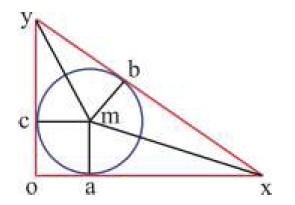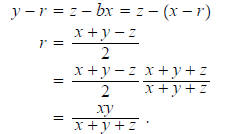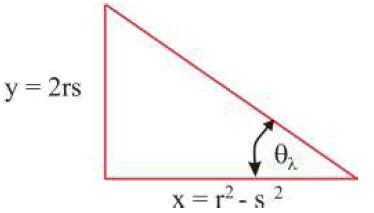A triple of positive integers x, y, z is called a Pythagorean Triple if these
integers satisfy the equation

For example, (3, 4, 5) is a Pythagorean Triple. A Pythagorean Triple is said
to be primitive if the integers are
relatively prime. That is, they have no common integer factor except 1. The
triple (3, 4, 5) is also a primitive
Pythagorean Triple.
1. If (x, y, z) is a primitive Pythagorean Triple show that
a. Exactly one of x and y is odd and hence that z must also be odd,
If both x and y are even that means z^2 must be even and thus so is z, which
means that x, y,
and z are not relatively prime; they’re all divisible by 2. If both x and y are
odd, then x^2+y^2
must be even. Note that this sum is not divisible by 4. However, since z^2 is
even z must be
even and this forces z^2 to be divisible by 4, a contradiction. So the only
alternative is that x and
y must have opposite parity, which forces z to be odd.
b. Exactly one of x and y is divisible by 3,
If both x and y are divisible by 3 then so is z, which contradicts the relative
primeness of x,
y, and z. If neither x nor y is divisible by 3, then x^2 and y^2 must have
remainder 1 when divided
by 3. so their sum must have a remainder of 2 when divided by 3, but z^2 can
only have
remainder 0 or 1, when divided by 3. Thus, exactly one of x and y is divisible
by 3.
c. Exactly one of x, y, and z is divisible by 5.
Again, since the three integers are relatively prime, not all of x, y, and z are
divisible by 5.
If two of them are divisible by 5, then the third must also be divisible by 5,
which we know
cannot happen. The last case to consider is if none of them are divisible by 5.
However, the
square of any integer has remainder 1 or 4 when divided by 5: this means that
the third must
have remainder 0, or 2, or 3 when divided by 5, a contradiction. The only case
left is that one
in which exactly one of the three is divisible by 5.
2. Is there a Pythagorean triple of the form (2, y, z) ?
The answer is no. Suppose (2, y, z) is a Pythagorean triple. That is,

Since z-y and z+y are integers and are divisors of 4 they can take on the
values of 1, 2, or 4 only. If
z-y is 1, then z+y=4. This means that z=5/2, a contradiction. If both factors
are 2, we then have
z=2 and y=0, but Pythagorean triples consist of positive integers. Thus, there
is no Pythagorean triple
of the form (2, y, z) .
3. If (x, y, z) is a Pythagorean triple then the isosceles triangles with
sides of length 2x, z, z and 2y, z, z
have the same area.
The isosceles triangle with sides of length 2x, z, and z has area xy as does
the isosceles triangle with
sides of length 2y, z, and z. The altitude of the first triangle is y, while the
altitude of the second triangle is
x.
4. Let (x, y, z) be a Pythagorean triple. Let r be the radius of the
inscribed circle of the right triangle with
sides x, y, and z.

a. Show that r must be an integer with the value

In the figure above we have oc=oa=mc=ma=mb=r, triangles mcy myb are
congruent as are triangles mbx and axm. Thus,

Thus, we have

Since two of the three terms in the numerator of are
odd, the equation
are
odd, the equation

shows that r is indeed an integer.
b. Let n be any positive integer. Show that there is a right triangle whose
sides have integer
length and whose inscribed circle has radius n.
From problem 6 below we see that if k is any odd integer greater than 1, then
 is a Pythagorean triple. The inscribed circle for the corresponding
is a Pythagorean triple. The inscribed circle for the corresponding
right triangle has radius

As k goes through the odd integers 3, 5, 7, …, the
corresponding value of r goes through each
of the natural numbers. Note that this Pythagorean triple is also primitive.
5. If (x, y, z) is a Pythagorean triple, show there are integers m and n such
that z^2+xy=m^2+n^2; show
that a similar statement is true for z^2-xy.

Note that one of x and y is odd as is z. Thus, all four numerators are even ,
which implies that each ratio is
an integer .
6. For any odd integer k show that there is a primitive Pythagorean Triple,
(k, l, m) , such that
m=l+1. Your proof should be constructive. That is, given k how do you find l and
m.
Note: (3, 4, 5) and (15, 112, 113) are both Pythagorean triples with the desired
property.
Given k set and
and
 Since
k is odd both l and m are integers, and it is an easy
Since
k is odd both l and m are integers, and it is an easy
computation to verify that is
a Pythagorean triple whose second and third terms
is
a Pythagorean triple whose second and third terms
differ by 1.
7. Suppose the λ is a positive rational number . That is, λ=m/n with m and n positive
integers. Find
necessary and sufficient conditions on m and n such that is
also rational.
is
also rational.
A necessary and sufficient condition is that m and n are the smaller two
integers in a Pythagorean
triple. Suppose first that there is a z ∈N such that
m^2+n^2=z^2, then we have

Conversely, suppose that  is a rational
number a/b in lowest terms . Then
is a rational
number a/b in lowest terms . Then

Since a and b are in lowest terms and b^2 divides a^2n^2 we know that b^2
divides n^2, which implies that b
divides n. Thus, there is a k such that n=bk, and we see that

That is, m and n are the smaller two numbers of a Pythagorean triple.
8. Show that if (x, y, z) is a primitive Pythagorean Triple (assume that y is
even) then there are integers r
and s of opposite parity such that

and the greatest common divisor of r and s is 1.
Since we have a primitive Pythagorean triple the integers x and z are
relatively prime, which implies
that the integers z-x/2 and z+x/2 are also relatively prime. Remember, we are
assuming that y is even,
which forces x and z to be odd. Thus ,we have

Since the integers z-x/2 and z+x/2 are relatively prime, and each divides the
square of an integer, their
square roots must also be integers. That is
 are
integers, and we have
are
integers, and we have

Since x and z are both odd r and s must be of opposite parity, and since x,
y, and z have no common
divisors neither can r and s.
9. Prove that there is no isosceles right triangle with sides of integer
lengths, but given any ∈>0, there is a
Pythagorean triple, such that the right triangle with side lengths given by the
triple has the property that
the smaller of the non-right angles is within of ∈of π/4
Suppose we had an isosceles right triangle with sides of length a, a, and b.
Then we have the
equation
2a^2=b^2,
which implies that sqrt(2)=b/a a rational number, but sqrt(2) is not
rational. This contradiction tells us that an
isosceles right triangle cannot exist.
To see that we can get one of the acute angles of a right triangle as close
as we want to 45°, we use
the result of problem 8.

To have angle θλ close to π/4, we show that we can pick r and s so that its
tangent is close to one.

Let λ=r/s. Then we want to pick λ so that
 is close to one. Suppose this ratio is equal to 1. Then
is close to one. Suppose this ratio is equal to 1. Then
must equal  . Since λ is the ratio of two positive integers, we want
λ equal to
. Since λ is the ratio of two positive integers, we want
λ equal to  . This can’t
. This can’t
happen for rational λ , but we can pick a sequence of rational numbers λn that
converge to  . That
. That
is, we can pick a sequence of positive integers rn and sn
such that
 is arbitrarily close to
is arbitrarily close to  ,
,
which means that tanθλn is arbitrarily close to 1, and hence
θλn is as close to π/4
as desired



